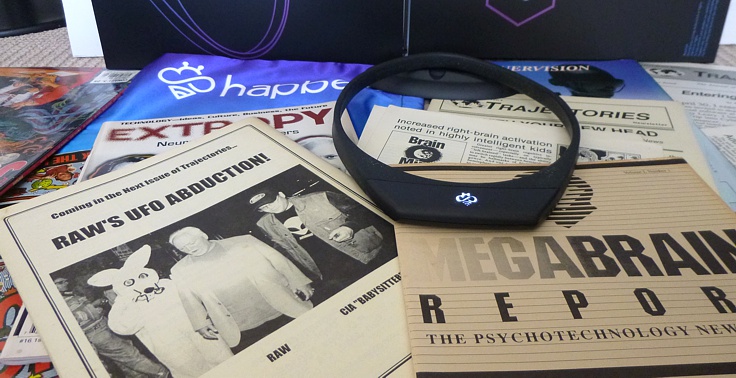
Third part of an occasional series on developments in brain machines – a subject in which RAW took a keen interest. (See also Part 1 & Part 2)
Mood-shifting wearable?
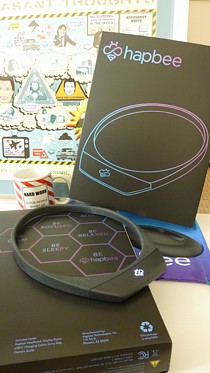
“Hapbee is a wellness wearable that delivers the molecular signature of compounds like caffeine, TGHC, CBD, nicotine, melatonin, etc… through magnetic waves.” – Hapbee website
For the last two months I’ve been testing a device called a “Hapbee”. In Trajectories #2 (1988), in a long article on the “H.E.A.D. Revolution”, RAW outlined two emerging families of brain machines: 1) light and sound, and 2) direct electromagnetism. The Hapbee falls into the latter group, although it boasts a new technology that distinguishes it from devices that RAW tested.
I mentioned the Hapbee’s development briefly in an earlier post, when it was still at prototype stage: “Those who have tried the prototype typically describe it with superlatives, suggesting it may be revolutionary, game-changing, etc.”
It uses ulRFE® waves (ultra-low radio frequency energy) generated by a portable device that you wear around your neck, or on your head – allowing you, or so its developers claim, to shift mood-states on demand. There are various signals you can choose from, each apparently delivering a “digital fingerprint” of a particular state – “focus”, “calm”, “happy”, etc. The idea is that you “play” a given mood directly into your brain, in the same way you’d play a drama on Netflix.
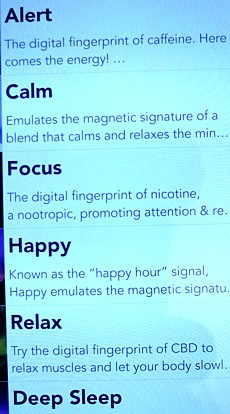
Stop Press: Yesterday (20 Sept 2021) Hapbee Technologies, Inc announced the addition of “18 new signal blends” to its library. This increases the number of signals available from 7 to 25. New signal blends include: ‘Morning Coffee’, ‘Power Nap’, ‘Zen Companion’, ‘Chill Out Your Senses’, ‘Creative Boost’, and ‘Out on the Town’.
RAW’s note of caution
It’s worth noting that after RAW’s initial enthusiasm for direct electromagnetism-generating machines such as the Pulstar, EndoMax and Graham Potentializer, he changed his mind somewhat over the safety implications, and in a later edition of Trajectories (#8, 1990) wrote the following:
“I do feel increasingly dubious about electrical brain machines; the data from related fields does disturb me, and — to play fair with all of you — I must now declare that I have personally stopped all self-research with electrical brain machines. I don’t feel sure of how to calculate the risk factor, and the debate between Becker, Beck and Kirsch confused me more than it enlightened me, so I prefer to experiment only with light and sound machines or with the ABR tapes.”
RAW, Trajectories #8, 1990
Does the Hapbee work & is it safe?
To be honest, I felt disappointed with
my experiences using the Hapbee
after all the hype and expectation
The Hapbee’s developers cite a lot of science and extensive testing on safety and effectiveness – they claim to build on years of research conducted by another company (Emulate Therapeutics) that invested in this new technology for medical applications.
But, of course, you make your own (hopefully informed) evaluations on risk. Remember: it’s a profit-making company and a new technology that directly affects the brain. I’m also aware of the field’s potentially sinister applications. If it’s possible to deliver a digital signature of “happiness” directly to your brain through generated electromagnetic waves, then it’s presumably also possible to deliver magnetic signatures of fear, paranoia, guilt and disquiet.
Anyway, I’ll leave those aspects aside for now – and instead consider if I found it any good.
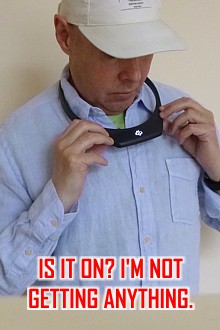
To be honest, I felt disappointed with my experiences using the Hapbee after all the hype and expectation. I found the effects so “subtle” that I wondered if they existed at all (in the conventional sense of “objective” versus “imaginary” or placebo – a tricky distinction with subjective states, and without a laboratory to do double-blind stuff!). The signal that seemed, possibly, to have the most pronounced effect – seemed (ie I might be deceiving myself) – was the straightforward “Relax”, described on the app as “digital fingerprint of CBD”.
That might just be me, of course. Others have reported more noticeable effects. After practising various forms of meditation for three and a half decades, I thought I was fairly sensitive to subtle “mind-body state” shifts. Certainly I experience definite and repeatable (though subtle) effects with, say, an Alpha-stim device or real CBD oil.
Hapbee team replies to my queries
I asked the Hapbee’s customer service people about the lack of effects I experienced. This is their reply:
Hi,
It sounds like you’re having a little trouble distinguishing between Hapbee signals.
Early users and beta testers have described the Hapbee sensations approximately on the level of drinking a single cup of coffee or the first beer during happy hour. Hapbee isn’t a knock-your-socks-off sensation.
One technique that has helped users notice the Hapbee sensations is to alternate between opposing signals in the following pattern:
30 min Alert
5 min break
30 min Sleepy
Finally, we also expect a small percentage of users to be non-responders for one biological reason or another. Expanding our understanding of the platform is one of the core goals of Hapbee R&D, which is why we offer a comprehensive return and refund policy.
I tried their alternating signals suggestion. Maybe it worked; maybe it didn’t – too subtle. I then asked the Hapbee customer service guy what factors influenced the strength of effect (eg session duration, direct contact with skin vs over clothing, position on body?). And I queried why the Hapbee literature repeatedly recommended that people drink plenty of water – and whether this was relevant to the device’s performance, or just general health-advice filler). No response from them to those questions, unfortunately. (Update, 4 Oct 2021 – I’ve now received a reply: placement doesn’t matter; drinking water is advice for those who feel negative side effects).
Dependence on phone app
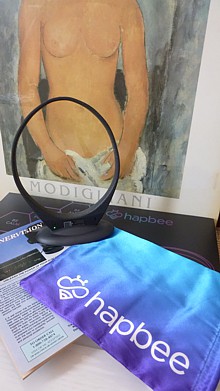
Another issue I have with the Hapbee is its reliance on an app that will only work in a relatively new smartphone (iPhone or Android). My phone was too old! (I had to get hold of a newer one). And there’s no Hapbee app for laptop or desktop PCs or Macs.
Even after I got hold of a newer phone, I couldn’t get the app to work properly – it kept freezing. The problem, as it turned out, was that I needed to switch on my phone’s “location services” (I leave this switched off by default). No mention of this in the instructions – and I’ve no idea why the Hapbee app requires that your phone is connected to the internet with location monitored – since it uses Bluetooth to pair with the Hapbee device.
Update (26 Sept 2021): The latest update to the Hapbee app includes a pop-up notification mentioning that it uses your phone’s location services. The brief reason it gives makes no sense to me, and it looks like a hasty addition. Further Update (18 Jan 2022): I’ve noticed some improvements to the app’s functioning since last year – it seems the Hapbee development team are taking onboard some of the criticisms.
Mobile annoyance?
I feel reluctant to be too critical of the Hapbee on this, since it’s more of a general trend with applications. So when it feels like the signal I’m playing is “Grumpy Old Man”, I try to remind myself of the, no doubt, heroic levels of idealistic work that produced these innovations.
And I can understand why software developers focus on mobile phone apps: the combination of unbelievable “off-the-shelf” processing power, appeal to a younger market, and efficient monetization potential built in.
Did I mention monetization? Why develop an app for a laptop or a desktop PC, when you can “simplify” the choices available to a user on a tiny phone screen? On a laptop/desktop there are literally hundreds of thousands of screen locations to click with precision (with a cursor) to do something other than make a purchase, respond to a binary ACCEPT/CANCEL algorithm choice, or otherwise “share” your info with a friendly data-leeching company. On a phone screen I can fit just four thumb-widths, if I’m lucky (I have medium-sized hands) – so the options for avoiding tapping where mercenary developers want you to tap… seem fewer.
But that’s just the dominant business model for phone apps. I don’t blame the companies. The apps come free (typically) – how else are they to make money other than to display ads or suck your data, or collect your responses to simple choices over time for monetizing-algorithm purposes?
Right business model for brain machines?
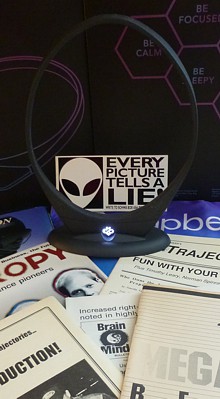
Does the “standard” phone-app business model really seem a good pairing with brain machines? I can think of several reasons why it looks a terrible combination. Firstly, users are forking out a lot of dough for these machines – not “getting stuff for free” (the app model). When you initially purchase the Hapbee device, you sign up to an additional monthly payment which apparently funds new mood signals that you can download to the app as they become available. But the usability of the app seems tied in to whether you keep up these payments. Update (18 Jan 2022): I discontinued monthly payments some months ago, but the functionality seems the same – ie it remains usable as before. However, I’ve found that I’m no longer using the device because it simply doesn’t work for me. You can’t say I haven’t persisted!
Secondly, the phone-app business model tends to work by maximising engagement with the apps. Think distraction and even addiction. That doesn’t seem a great pairing with a brain machine whose functions may include “calm”, “focus”, “relaxation”, etc. (If you’re meditating, sleeping, relaxing, etc, I think it can be a good idea, generally, to silence your phone and put it out of the way, in another room. Not have it paired with the device that’s supposedly transforming you into a Zen Master!).
And thirdly, why not go for the greater degree of user control, precision and explorative and creative possibilities offered by a laptop/desktop application? We’re talking brain machines and “enlightenment”, not instant messaging, Candy Crush and fucking Instagram!
Oops, sorry – I left the “G.O.M.” signal on. Let me just switch to the “Happy” digisig… There, that’s better. Forget all the above. They are a wonderful group of human beings, and you should buy their beautiful products so that we can all make the world a better place.
(This blog and its images were created on a laptop computer with a 15.6″ screen. No smartphones were used – no cruelty was inflicted on eyes or neurons).
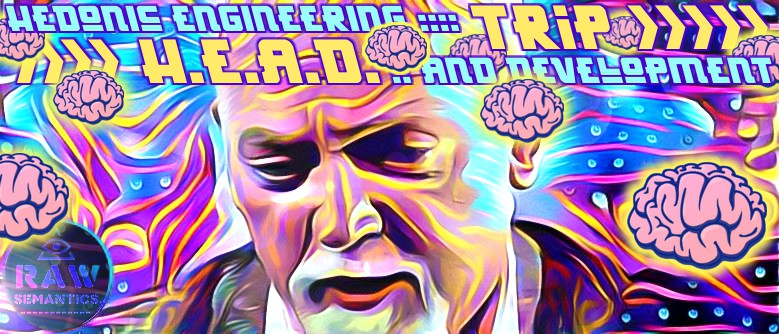
This is prob the best blog I have come across. And this is another enjoyable and informative RAW post. You should consider going the paid subscription route , as this is higher quality than a lot of the offerings out there.
LikeLike
Very kind – thanks. I think it helps to be a “somebody” on the paid route, although I admire the winning optimism of those who persevere with it.
LikeLike
It works both ways on the tech. Some people prefer iPhone apps, and not everyone wants to invest in a full-fledged desktop computer. I also think you’re too harsh on on Insta and games (candy crush) people like to play on their phones. It’s how you use it and there isn’t anything inherently terrible about these things. You show your age, my firends would laugh at your cynicism, and you almost come off as a technphobe towards the end. 🙂
LikeLiked by 1 person
Thanks, Stef. I know what you mean, and perhaps I should have written it differently. I intended it as tongue-in-cheek. I’m very far from being a technophobe! I actually went to great lengths to get hold of this device to try out, and had big expectations for it. But I felt I should be honest about my disappointment.
As for mobile technology in general, I find the hardware astounding and wonderful. I have friends and relatives who use iPhones to do practically everything – they love it, and they do laugh at me when I took out my (until recently) ancient dumb phone. One of them took pity on me a while back and gave me their old iPhone when they replaced it with a new model. That was the iPhone that was too old to use with the Hapbee. (I now have a newer, but still second-hand, Samsung Galaxy phone).
My tongue-in-cheek “grouch” comments arose from the irony I see in combining a device designed to lift your mood-states with a device shown* to make you more depressed and anxious (given statistically typical usage of social media, etc). But I take your point about “it’s how you use it”. Certainly it seems possible to benefit from the amazing hardware without succumbing to the more distracting, monetizing items of software.
*I’ve written about this before. There’s a huge amount of research (including from the social media giants themselves, who are aware of the problem) that does amount to fairly solid empirical evidence on the depressing effects. See, for instance, Jaron Lanier’s eloquent observations and arguments on the subject, which I’ve referenced here and here.
In addition to this problem (a consequence of monetizing algorithms), there’s the problem of *noise* in communication, which RAW wrote repeatedly about. The formats of social media seem to exacerbate that, if anything. It seems as easy to misinterpret and misattribute motive, etc, as it is to be misinterpreted and misread. It helps to occasionally take a long break from social media of all kinds!
LikeLike
Interesting to read the reviews of the Hapbee app on Google play. A lot of unhappy customers. Not that I’m saying it’s like the hardware equivalent of Scientology or anything.
https://play.google.com/store/apps/details?id=com.elevation.hapbee&showAllReviews=true
LikeLiked by 1 person